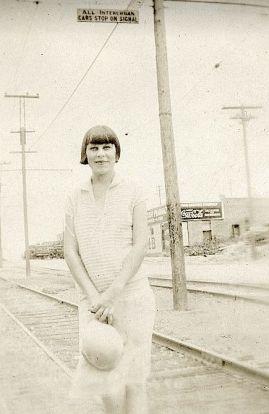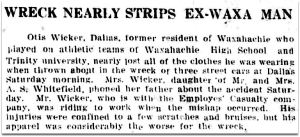Cedar Crest, L. O. Daniel’s Country Home

Still standing on West Jefferson Blvd. in Oak Cliff
by Paula Bosse
While looking for something on W. Lee “Pappy” O’Daniel (former governor and U.S. senator), I came across the image above, which I had mistakenly labeled “O’Daniel” rather than “Daniel.” It had nothing at all to do with W. Lee O’Daniel but, instead, showed a house belonging to L. O. Daniel. Who was L. O. Daniel? I’d never heard of him.
Lark Owen Daniel Sr. (1866-1927) was a wealthy businessman who made big money from… hats! He sold a lot of hats through his wholesale millinery company, and he was also involved in some spectacular real estate dealings (a newspaper article in 1907 mentioned he had just sold a couple of lots on Elm Street for $30,000 — if you believe online inflation calculators, that would be the equivalent of almost a million dollars in today’s money!). As a proven earner of big bucks, he was also the first president of the Dallas Chamber of Commerce.
Even before that huge real estate sale, Daniel was swimming in hat-cash. In 1901 he bought 27 acres near the Fort Worth Interurban rail line and built a 5,000-square-foot, 3-story, 15-room Victorian mansion. He named the house “Cedar Crest.” I don’t know if it was technically in Oak Cliff at that point, but it was definitely outside the Dallas city limits. This is the way Daniel’s address appeared in the 1910 city directory:
And here’s a photo of an interurban trundling along, uncomfortably close to the house:
The luxurious splendor of the somewhat isolated Cedar Crest apparently emitted a high-pitched siren-call which was frequently heard by area bandits: it was burgled quite a few times (at least 3 times in one 12-month period). After one incident in which a burglar wandered through the house in the dead of night and woke Mrs. Daniel as he stood over her as she lay in bed, Oak Cliff police said that they found no trace of the trespasser but saw where he had hitched his horse and get-away buggy, out back in the orchard. In another incident a few months later, Mrs. Daniel — who had been alerted by an employee that the family car was about to be stolen from the “automobile house” — ran out to the garage armed with a revolver and fired three shots at the thieves, scaring them away (I don’t think she was attempting to fire warning shots — I think she fired AT them). This may seem extreme, but the newspaper noted that the value of the car (in 1915) was an eye-watering $4,000 (more than $110,000 in today’s money!). I don’t know where Mr. Daniel was during all this, but Mrs. Daniel was not about to let that car go anywhere!
One summer, the Daniels rented out Cedar Crest while they vacationed elsewhere. The ad in the paper specified that only “responsible parties without small children” were welcome. I hate to keep harping on about the money, but a two-month stay at L. O.’s “beautiful country home” would set some responsible childless person/s back a cool $300 (almost $9,000 in today’s money). (Who would pay such an exorbitant amount of money to stay in an un-airconditioned house in North Texas during the height of the summer?)
L. O. Daniel died in Feb. 1927. His business empire was closed down, and the large Cedar Crest swath of land he owned was put up for sale in 1929.
I’m not sure what happened with that specific transaction, but his son, L. O. Daniel Jr., ended up breaking that land up into parcels and selling residential lots as part of the “L. O. Daniel Jr. Addition,” beginning in about 1940.
*
This beautiful house is — somehow — still standing. It is located at 2223 West Jefferson in Oak Cliff, facing Sunset High School (see it on Google Street View here). Over the years the mansion fell into disrepair, but in the early ’80s the house was restored by two men — Martin Rubin and Earl Remmel — and it received historical landmark status in 1984. Cedar Crest was purchased a few years ago and has gone through additional restoration/renovation — it currently serves as the impressive law offices for the firm of Durham, Pittard & Spalding.
There are lots of photos online. View some on the Zillow site — which show what it looked like before it was recently updated — here. See some really beautiful photos on CedarCrestOakCliff.com, here. I particularly love this one:
**
It shouldn’t have been so hard to find a photo of L. O. — but this is about all I could find. Followed by a hats-hats-hats! ad.
***
Sources & Notes
Postcard at top (circa 1909) found a few years ago on the Flickr stream of Coltera (not sure if he’s still posting there — if not, that’s a shame, because he had amazing things!).
Photo of the interurban from the 2017 Oak Cliff Advocate article “Law Firm Renovates Historic Mansion on Jefferson” by Rachel Stone (click the link at the bottom of the article to read a piece published in Texas Lawyer which includes information on specific restoration/renovation work done on the house).
There are so many great homes in the L. O. Daniel area — look at a whole bunch on the L. O. Daniel Neighborhood Association website here.
Also recommended is the 2019 Candy’s Dirt article “What’s in a Name For L. O. Daniel?” by Deb R. Brimer.

*
Copyright © 2022 Paula Bosse. All Rights Reserved.


























































